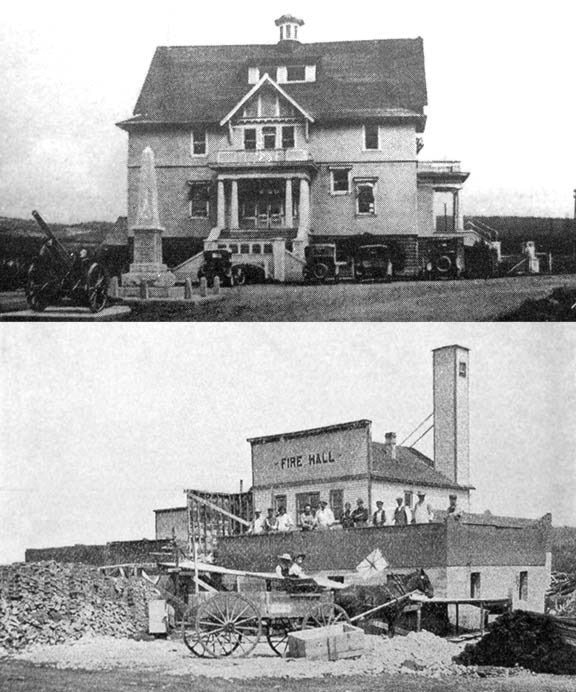Jim Cameron
The incorporation of Cranbrook as a city in November, 1905, was a big undertaking involving the rapid creation of a complete municipal infrastructure.
The initial council meeting involved the necessary establishment of priorities, and among them was that of a city police force. Previously the town was patrolled by two provincial constables with occasional assistance from the CP Railway Police. The new city police force required not only a chief and a constable but a jailer and a police magistrate under a police commission consisting of two aldermen and the mayor.
Amidst some disagreement city council decided to hire R.S. Baron as Chief of Police and Duncan McLean as Constable, at salaries of $85 and $70 respectively per month. The magistrate, R.A. Anderson, received $40 and the jailer $35.
The next step was to consider the courthouse and jail, and that was a bit of a stickler. Built in October, 1898, near the Royal Hotel (the present day Byng), the seat of justice was a sad affair by all accounts. Chief Baron suggested converting the court room to something resembling a parallelogram by incorporating part of the jail office. Wire lattice could be put on the cell windows to prevent the passing of weapons and liquor from the outside and suitable lighting added to the rear of the building. He further pointed out that a prisoner's dock was required, the interior walls in dire need of repair and more wood was required to keep prisoners from freezing, all of which gives some indication as to the state of the place at the time.
Still, it was what it was and what it was would have to do.
For the prisoners the most pressing problem was food and, so saying, they went on strike for better fare in April, 1906. At the time the city allotted a 50 cent food allowance per prisoner per day (somewhere around $15-20 by today's standards) to feed prisoners often required to do heavy manual labour around the town in return. The food matter was referred to the police commission.
The first official police report of January, 1899, showed court revenue of $10 and expenses of $312.35. Not good. The report for April showed greatly increased revenue of $363.30, much of it garnered from fines imposed upon the local girls of the red light district. Catch as catch can, as they say.
The city jailer was appointed as the town pound-keeper, not primarily for dogs as might be imagined, but for cattle running loose within city boundaries.
The council also turned down a request for an additional constable, thus paving the way for an ongoing underfunding of local city police.
Further, it appears the police magistrate was unhappy with the courthouse now being used as a cook house for the prisoners.
District law enforcement was on the rise, however. In September, 1899, Cranbrook police joined the district Chief Constable Association recently formed in Nelson for the purpose of ensuring co-operation between neighbouring forces in apprehending criminals, the results of which proved beneficial.
Police-wise, things progressed rather well until March, 1907, when the local paper published comments allegedly spoken during a sermon given in Toronto by Rev. Kilpatrick, a recent visitor to the city, describing Cranbrook as "the Seat of Satan" and the "the Sodom of the West."
Rev. Kilpatrick denied all charges in a letter to the citizens of Cranbrook, expressing "admiration for a beautiful city." He did, however, disagree with "segregation of a certain form of vice."
The local council worked itself into a minor frenzy, finally choosing gambling as the main vice in question followed by sales of tobacco to minors — prostitution, liquor and drugs did not seem to figure — and decided changes were needed.
It is not known whether Chief Baron left of his own accord or not but the call went out for a new police chief and, within a month, Cory Dow was duly sworn in, having been the only ratepayer to apply for the job. Constable McLean retained his position as he would for many years to come. Both men received a salary increase with two suits of clothes per year thrown into the bargain.
A. A. Ward, a provincial constable from Marysville, took the job as jailer/pound keeper which now included caretaking of the fire hall, the council and town clerk's chambers (such as they were) and miscellaneous policing duties. He resigned six months later.
G. Moore took over his position and resigned six months later. Overwork and underpayment may have been a factor.
Jailer's duties aside, the town experienced very little serious crime in the first years of Chief Dow's reign. In 1908, city council considered the construction of an addition to the jail to allow the prisoners to cook their own food. No decisive action appears to have been taken.
Charges levied in 1909 by anonymous sources in a local moral reform publication "The Searchlight" accused Chief Dow of extorting fines from would-be law-breakers which he in turn pocketed himself. During a one-day trial he was completely exonerated. It was but a brief blip on the city's law enforcement radar.
As far as the local jail went, in June, 1910, a prisoner made his escape by simply pulling a wooden plank off the cell ceiling and using it to knock out the bars in the window. It spelled doom for the old lock-up. The city jail/courthouse was torn down in November, 1910, and temporary quarters set up in the new courthouse at the east end of Baker Street. By this time the present day city hall was under construction, the design of which included a number of jail cells in the basement, cells that would remain in use for decades to come.
janusthenandnow@shaw.ca
